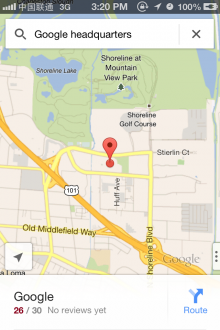
Anticipation for the Google Maps iPhone app, which finally arrived late Wednesday, has been building since Apple announced its own mapping solution, and it reached a peak after the resulting app failed to live up to expectations when it arrived in iOS 6.
The Maps situation has become a debacle. It caused a rare apology from Apple, and has been cited as playing a part in the departure of two executives – Scott Forstall, the company’s former head of iOS, and Richard Williamson, who oversaw development of the Maps app.
With numerous people blaming Apple when they get lost (Australian police even went so far as to call iOS Maps’ mistakes “potentially life threatening“), Google Maps is being hailed as somewhat of a savior. I realize that may sound overdramatic, but the hype surrounding the release is enormous.
The first native Google Maps app that Google has built separately from Apple is attractive with plenty of polish on it, but there are a few rough spots that suggest it’s been rushed ahead to market. Even so, I found the app to be pleasantly responsive and feature-rich.
Getting started
Google Maps opens with a stark reminder about one of the primary subjects in the custody battle between Apple and Google – user data. It boots up with a pre-filled checkbox that authorizes the app to send anonymous location back to Google to help it improve traffic and other services.

You can of course opt out of it, but the page is slightly misleading. The “Accept & Continue” button refers to agreeing to the Terms of Service and Privacy Policy, but the check mark seems to imply that it’s required. If you already authorized the data collection and want to disable it, you can, but it’s buried deep within the app. You’ll need to click on the person icon, then the settings gear, “About, terms & privacy”, “Terms & privacy”, “Location data collection”.
Once you’ve agreed to the terms of the page, you’ll be offered the chance to login to your Google account to populate the app with your data and information. It’s another departure from Apple’s philosophy toward Google’s strategy. Depending on what side you’re on, the pervasiveness of the data Google has collected on you is either one of it’s greatest strengths (Google Now) or its greatest evils (antitrust/privacy threat). The decision is up to you, but if you choose not to, the app will remind you every once in a while that it could be saving your favorite places and past searches across your computer and phone.
The new look
Google Maps for iPhone comes with a new look from the Web and desktop versions. I haven’t pinpointed exactly why it feels this way, but the iOS app feels softer. Almost like the maps are friendly comics or drawings, rather than a complex navigational framework. I imagine the look will appeal to the average consumer, though tech-savvy folks may find the interface to be too stripped down simplistic.

The main search page offers a search box, a routing arrow to jump right into getting directions and the person icon for managing your profile and settings. You’ll also see a compass indicator that orients you as you rotate the map and the location arrow in the bottom left corner for jumping right to your current location.
A small tab in the bottom right corner lets you pull out a task bar, which lets you toggle traffic, public transit and satellite options. It also contains a link to the Google Earth app. Public transit in particular is a welcome return, as Apple did not include the feature in its own version of Maps of iOS 6. Apple has instead allowed third-parties to submit their own transit data.

Other major features included in the new Google Maps are turn-by-turn navigation and Street View. However, turn-by-turn is currently listed as beta in the app, and it’s not available everywhere, as some international users are reporting only seeing a Preview button instead of the Start button needed to activate the voice navigation.

When you search for a location, its name will appear at the bottom of the screen. You can pull up on it to get more information about the destination, including a share button (limited to message, mail and copy to clipboard), save to favorites, and an option to call the venue. If Street View, photos and reviews are available, you’ll also be able to access them here.

One interesting feature about the app is that it comes with a shake to send feedback setting. You can always turn it off in the settings pane, but it is nice to know that the opportunity for a quick feature or bug rant is only a shake away.
I haven’t run any extensive real-world tests on the new Google Maps for accuracy, but since it should have access to the same data that the pre-iOS 6 Google/Apple Maps app had, I’m not anticipating any (new) complaints here.
I once was lost…
The Google Maps app is extremely responsive and, even on a middling connection, it’s capable of zooming in and out and rotating without the stuttering reloads that plagued earlier mapping applications. It’s a minor touch, but the slight momentum that continues after pinching or rotating a map makes the map feel more real. The mobile Web version of Google Maps feels lifeless when it simply stops right away and flickers when zooming.
There’s still plenty of room for improvement with the app, but that doesn’t change the fact that Google has done some excellent work here. If you’re disappointed that the new Google Maps is iPhone only, the company told The New York Times that a native iPad app is coming soon, along with features on the Android version that have yet to be added to the iOS edition, such as offline and indoor maps.
In the meantime, you can enjoy all the spare time that you’ll be gaining back from not being as lost anymore. Or, at least you’ll have one less thing to blame when it does happen.
Image credit: AFP/Getty Images
Disclosure: This article contains an affiliate link. While we only ever write about products we think deserve to be on the pages of our site, The Next Web may earn a small commission if you click through and buy the product in question. For more information, please see our Terms of Service.
Get the TNW newsletter
Get the most important tech news in your inbox each week.





